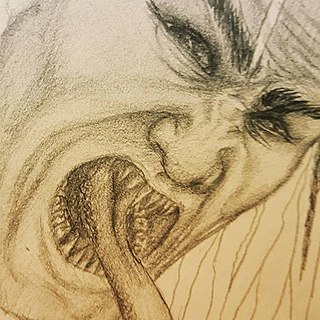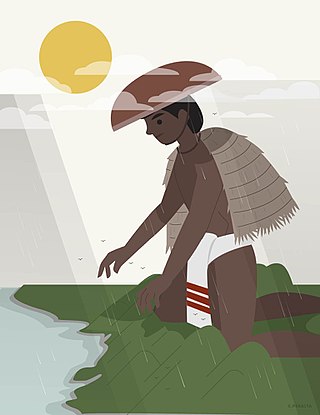The culture of the Philippines is characterized by cultural and ethnic diversity. Although the multiple ethnic groups of the Philippine archipelago have only recently established a shared Filipino national identity, their cultures were all shaped by the geography and history of the region, and by centuries of interaction with neighboring cultures, and colonial powers. In more recent times, Filipino culture has also been influenced through its participation in the global community.

The manananggal is a mythical creature in the Philippines that is able to separate its upper torso from the lower part of its body. Their fangs and wings give them a vampire-like appearance.
Philippine literature is literature associated with the Philippines from prehistory, through its colonial legacies, and on to the present.

Aswang is an umbrella term for various shape-shifting evil creatures in Filipino folklore, such as vampires, ghouls, witches, viscera suckers, and transforming human-beast hybrids. The aswang is the subject of a wide variety of myths, stories, arts, and films, as it is well known throughout the Philippines. Spanish colonists noted that the aswang was the most feared among the mythical creatures of the Philippines, even in the 16th century. Although with no specific motive other than harming others, their behavior can be interpreted as an inversion of the traditional Filipino's values. The aswang is especially popular in southern parts of Luzon, and some parts of Mindanao and Visayas, especially the Visayan province of Capiz.

The Tikbalang (/ˈtikbaˌlaŋ/) is a creature of Philippine folklore said to lurk in the mountains and rainforests of the Philippines. It is a tall, bony humanoid creature with the head and hooves of a horse and disproportionately long limbs, to the point that its knees reach above its head when it squats down. In some versions, it is a transformation of an aborted fetus sent to earth from limbo.

Philippine mythology is rooted in the many indigenous Philippine folk religions. Philippine mythology exhibits influence from Indonesian, Hindu, Muslim, Shinto, Buddhist, and Christian traditions.

Philippine epic poetry is the body of epic poetry in Philippine literature. Filipino epic poetry is considered to be the highest point of development for Philippine folk literature, encompassing narratives that recount the adventures of tribal heroes. These epics are transmitted through oral tradition using a select group of singers and chanters.

Biag ni Lam-ang is an epic story of the Ilocano people from the Ilocos region of the Philippines. It is notable for being the first Philippine folk epic to be recorded in written form, and was one of only two folk epics documented during the Philippines' Spanish Colonial period, along with the Bicolano epic of Handiong. It is also noted for being a folk epic from a "Christianized" lowland people group, with elements incorporated into the storytelling.

Bernardo Carpio is a legendary figure in Philippine mythology who is said to be the cause of earthquakes. There are numerous versions of this tale. Some versions say Bernardo Carpio is a giant, as supported by the enormous footsteps he has reputedly left behind in the mountains of Montalban. Others say he was the size of an ordinary man. Accounts of the stories have pre-colonial origins, but the name of the hero was Hispanized during the Spanish colonization. The original name of the hero has been lost in time. All versions of the story agree that Bernardo Carpio had a strength that was similar to that of many strong men-heroes in Asian epics, such as Lam-ang.
Amihan is a genderless deity that is depicted as a bird in the Philippine mythology. According to the Tagalog folklore, Amihan is the first creature to inhabit the universe, along with the gods called Bathala and Aman Sinaya. In the legend Amihan is described as a bird who saves the first human beings, Malakas and Maganda from a bamboo plant.

Felipe Landa Jocano was a Filipino anthropologist, educator, and author known for his significant body of work within the field of Philippine Anthropology, and in particular for documenting and translating the Hinilawod, a Western Visayan folk epic. His eminence within the field of Philippine anthropology was widely recognized during his lifetime, with National Artist F. Sionil Jose dubbing him "the country's first and foremost cultural anthropologist"

Agimat, also known as anting or folklorized as anting-anting, is a Filipino word for "amulet" or "charm". Anting-anting is also a Filipino system of magic and sorcery with special use of the above-mentioned talismans, amulets, and charms. Other general terms for agimat include virtud (Virtue) and galing (Prowess).
The tiyanak is a vampiric creature in Philippine mythology that takes on the form of a toddler or baby. Although there are various types, it typically takes the form of a newborn baby and cries in the jungle to attract unwary travelers. Once it is picked up by an unfortunate passerby, it reverts to its true form and attacks the victim. The tiyanak is also depicted to take malevolent delight in leading travelers astray, or in abducting children.
Damiana Ligon Eugenio was a Filipino female author and professor who was known as the Mother of Philippine Folklore, a title she received in 1986. Apart from teaching at the University of the Philippines, she has several publications in the field of Philippine folklore, among them a series of seven books which she compiled and edited.

The indigenous religious beliefs of the Tagalog people were well documented by Spanish missionaries, mostly in the form of epistolary accounts (relaciones) and entries in various dictionaries compiled by missionary friars.
Esperidión Arsenio Manuel, known as E. Arsenio Manuel, was a Philippine academic, historian, and anthropologist best known for his contributions to Philippine anthropology, history, literature, and linguistics. During a three-decade academic career at the University of the Philippines, he wrote a seminal survey of Philippine folk epics, and was responsible for discovering and publishing folk epics from the Manuvu, Matigsalug, and Ilianon peoples.

Angalo is a legendary creation giant from Ilocano mythology with pre-Hispanic origins in the Ilocos region of the Philippines. Angalo was the first man, and son of the god of building. Angalo's head touched the sky and he could easily walk from the Ilocos Region to Manila in one step. Through Angalo's actions, he shaped the hills and mountains of Luzon, formed the oceans, and put up the sky, sun, moon and stars. Pre-Hispanic Ilocano people attributed the sound of thunder as Angalo's voice, earthquakes as his movements, and rainbows his hanging G-string. Angalo was not alone, he had a giant wife named Aran and together they had three daughters whom the Ilocano, Aeta, and Igorot people are descendants.










